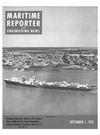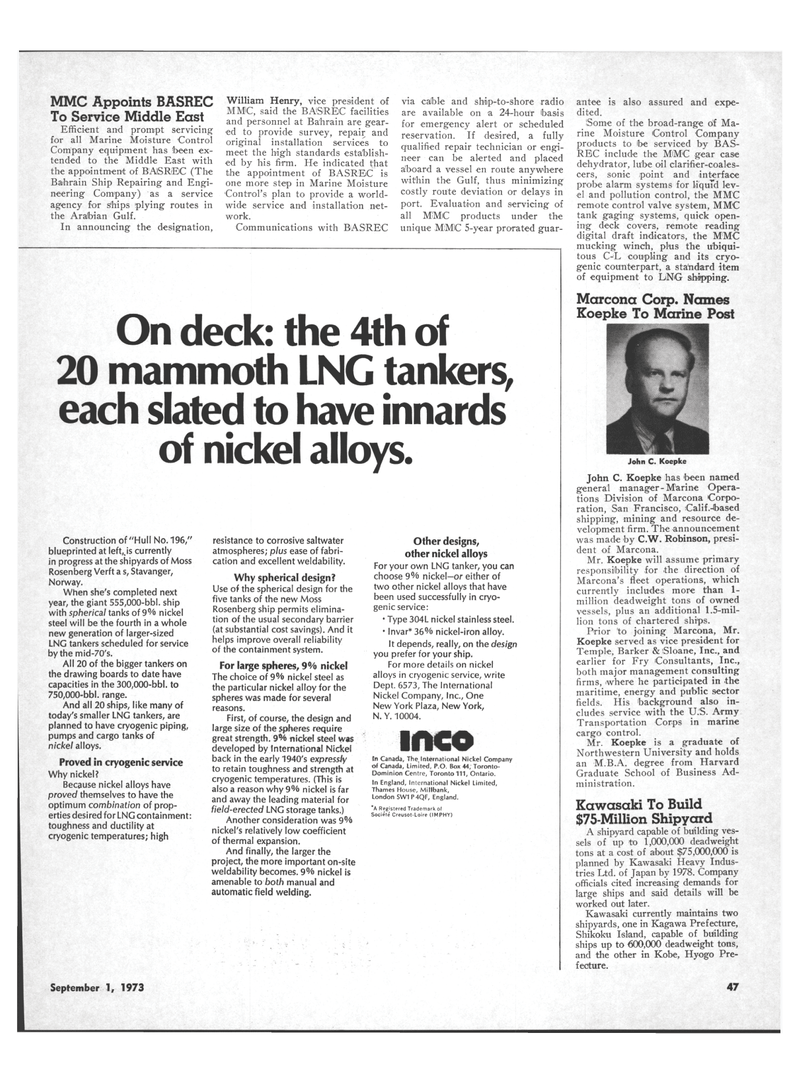
Page 43: of Maritime Reporter Magazine (September 1973)
Read this page in Pdf, Flash or Html5 edition of September 1973 Maritime Reporter Magazine
MMC Appoints BASREC
To Service Middle East
Efficient and prompt servicing for all Marine Moisture Control
Company equipment has 'been ex- tended to the Middle East with the appointment of BASREC (The
Bahrain Ship Repairing and Engi- neering Company) as a service agency for s'hips plying routes in the Arabian Gulf.
In announcing the designation,
William Henry, vice president of
MMC, said the BASREC facilities and personnel at Bahrain are gear- ed to provide survey, repair and original installation services to meet the high standards establish- ed by his firm. He indicated that the appointment of BASREC is one more step in Marine Moisture
Control's plan to provide a world- wide service and installation net- work.
Communications with BASREC via cable and ship-to-shore radio are available on a 24-hour basis for emergency alert or scheduled reservation. If desired, a fully qualified repair technician or engi- neer can be alerted and placed aboard a vessel en route anywhere within the Gulf, thus minimizing costly route deviation or delays in port. Evaluation and servicing of all MMC products under the unique MMC 5-year prorated guar-
On deck: the 4th of 20 mammoth LNG tankers, each slated to have innards of nickel alloys.
Construction of "Hull No. 196/' blueprinted at leftjs currently in progress at the shipyards of Moss
Rosenberg Verft a s, Stavanger,
Norway.
When she's completed next year, the giant 555,000-bbl. ship with spherical tanks of 9% nickel steel will be the fourth in a whole new generation of larger-sized
LNG tankers scheduled for service by the mid-70's.
All 20 of the bigger tankers on the drawing boards to date have capacities in the 300,000-bbl. to 750,000-bbl. range.
And all 20 ships, like many of today's smaller LNG tankers, are planned to have cryogenic piping, pumps and cargo tanks of nickel alloys.
Proved in cryogenic service
Why nickel?
Because nickel alloys have proved themselves to have the optimum combination of prop- erties desired for LNG containment: toughness and ductility at cryogenic temperatures; high resistance to corrosive saltwater atmospheres; plus ease of fabri- cation and excellent weldability.
Why spherical design?
Use of the spherical design for the five tanks of the new Moss
Rosenberg ship permits elimina- tion of the usual secondary barrier (at substantial cost savings). And it helps improve overall reliability of the containment system.
For large spheres, 9% nickel
The choice of 9% nickel steel as the particular nickel alloy for the spheres was made for several reasons.
First, of course, the design and large size of the spheres require great strength. 9% nickel steel was developed by International Nickel back in the early 1940's expressly to retain toughness and strength at cryogenic temperatures. (This is also a reason why 9% nickel is far and away the leading material for field-erected LNG storage tanks.)
Another consideration was 9% nickel's relatively low coefficient of thermal expansion.
And finally, the larger the project, the more important on-site weldability becomes. 9% nickel is amenable to both manual and automatic field welding.
Other designs, other nickel alloys
For your own LNG tanker, you can choose 9°/o nickel—or either of two other nickel alloys that have been used successfully in cryo- genic service: • Type 304L nickel stainless steel. • Invar* 36% nickel-iron alloy.
It depends, really, on the design you prefer for your ship.
For more details on nickel alloys in cryogenic service, write
Dept. 6573, The International
Nickel Company, Inc., One
New York Plaza, New York,
N. Y. 10004. inco
In Canada, The International Nickel Company of Canada, Limited, P.O. Box 44, Toronto-
Dominion Centre, Toronto 111, Ontario.
In England, International Nickel Limited,
Thames House, Millbank,
London SW1 P4QF, England. "A Registered Trademark of
Societe Creusot-Loire (IMPHY) antee is also assured and expe- dited.
Some of the broad-range of Ma- rine Moisture Control Company products to foe serviced by BAS-
REC include the MiMC gear case dehydrator, lube oil clarifier-coales- cers, sonic point and interface probe alarm systems for liquid lev- el and pollution control, the MMC remote control valve system, MMC tank gaging systems, quick open- ing deck covers, remote reading digital draft indicators, the MMC mucking winch, plus the ubiqui- tous C-L coupling and its cryo- genic counterpart, a sta'ndard item of equipment to LiNG shipping.
Marcona Corp. Names
Koepke To Marine Post
John C. Koepke
John C. Koepke has 'been named general manager-M'arine Opera- tions Division of Marcona Corpo- ration, San Francisco, Calif.-foased shipping, mining and resource de- velopment firm. The announcement was made by C.W. Robinson, presi- dent of Marcona.
Mr. Koepke will assume primary responsibility for .the direction of
Marcona's fleet operations, which currently includes more than 1- million deadweight tons of owned vessels, plus an additional 1.5-mil- lion tons of chartered ships.
Prior to joining Marcona, Mr.
Koepke served as vice president for
Temple, Barker & Sloane, Inc., and earlier for Fry Consultants, Inc., both major management consulting firms, where he participated in the maritime, energy and public sector fields. His background also in- cludes service with the U.S. Army
Transportation Corps in marine cargo control.
Mr. Koepke is a graduate of
Northwestern University and holds an M.B.A. degree from Harvard
Graduate School of Business Ad- ministration.
Kawasaki To Build $75-Million Shipyard
A shipyard capable of building ves- sels of up to 1,000,000 deadweight tons at a cost of about $75,000,000 is planned by Kawasaki Heavy Indus- tries Ltd. of Japan by 1978. Company officials cited increasing demands for large ships and said details will be worked out later.
Kawasaki currently maintains two shipyards, one in Kagawa Prefecture,
Shikoku Island, capable of building ships up to 600,000 deadweight tons, and the other in Kobe, Hyogo Pre- fecture.
September 1, 1973 47

 42
42

 44
44
